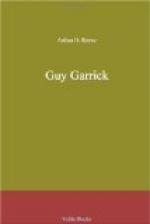I had been studying the photographs. It was a new idea, and it appealed to me strongly. “How about revolvers?” I asked quickly.
“Well, Dr. Balthazard, the French criminologist, has made experiments on the identification of revolver bullets and has a system that might be compared to that of Bertillon for identifying human beings. He has showed by greatly enlarged photographs that every gun barrel leaves marks on a bullet and that the marks are always the same for the same barrel but never identical for two different barrels. He has shown that the hammer of a revolver, say a centre fire, strikes the cartridge at a point which is never the exact centre of the cartridge, but is always the same for the same weapon. He has made negatives of bullets nearly a foot wide. Every detail appears very distinctly and it can be decided with absolute certainty whether a certain bullet or cartridge was fired by a certain revolver.”
He had picked up one of the microphotographs and was looking at it attentively through a small glass.
“You will see,” he explained, “on the edge of this photograph a rough sketch calling attention to a mark like an L which is the chief characteristic of this hammer, although there are other detailed markings which show well under the microscope but not in a photograph. You will note that the marks on a hammer are reversed on the primer in the same way that a metal type and the character printed by it are reversed as regards one another. Moreover, depressions on the end of a hammer become raised on the primer and raised markings on the hammer become depressions on the primer.
“Now, here is another. You can see that it is radically different from the first, which was from the cartridge used in killing poor Rena Taylor. This second one is from that gun which I found on the tenement roof this morning. It lacks the L mark as well as the concentric circles. Here is another. Its chief characteristics are a series of pits and elevations which, examined under the microscope and measured, will be found to afford a set of characters utterly different from those of any other hammer.
“In short,” he concluded with an air of triumph, “the ends of firing pins are turned and finished in a lathe by the use of tools designed for that purpose. The metal tears and works unevenly so that microscopical examination shows many pits, lines, circles, and irregularities. The laws of chance are as much against two of these firing pins or hammers having the same appearance under the microscope as they are against the thumb prints of two human subjects being identical.”
I picked up the curious little arrangement which we had found in the drawer in Forbes’ room and examined it closely.
“I have been practicing with that pistol, if you may call it that,” he remarked, “on cartridges of my own and examining the marks made by the peculiar hammer. I have studied marks of the gun which we found on the roof. I have compared them with the marks on cartridges which we have picked up at the finding of Rena Taylor’s body, at the garage that night of the stupefying bullet, with bullets such as were aimed at Warrington, with others, both cartridges and bullets, at various times, and the conclusion is unescapable.”




